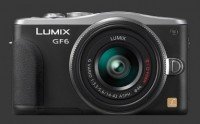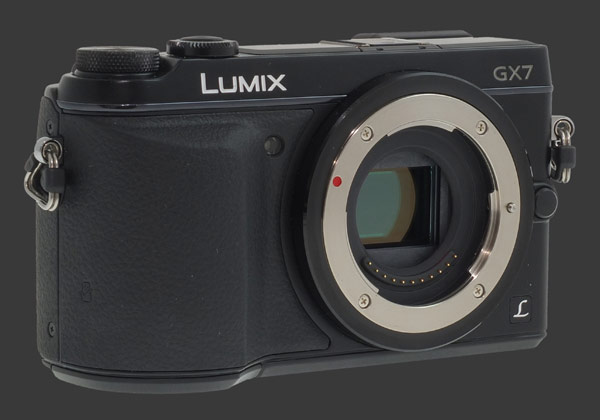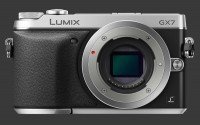Panasonic Lumix DMC-GX7 Review
Panasonic Lumix DMC-GX7 Performance - How well does it take pictures?
Performance starts with image quality, which is the criteria used as the foundation of our digital camera ratings. Ergonomic issues may get in the way, but in the end, image quality counts the most. For an ILC, image quality greatly depends on the lens used. While color, noise, exposure and dynamic-range are properties of a camera, distortion, vignetting and chromatic aberrations are properties of the lens. Sharpness and contrast depend on the weakest link. That is, a camera cannot capture more details than a lens lets through. Conversely, it is quite possible for a lens to transmit more details than a sensor can capture.
Image Noise & Details
The Panasonic Lumix DMC-GX7 shows good image quality with relatively low image noise up to ISO 1600. It offers 11 steps of noise-reduction, more than any camera except the GF6
Panasonic Lumix DMC-GF6. This ranges from virtually no removal to brutally destroying image details. At -2, noise-reduction does a reasonable job of balancing details and the appearance of noise which is almost entirely achromatic.

Noise is actually visible at ISO 1600 but details are nicely retained. ISO 3200 is more noisy and details start being affected. This reduces possible print sizes a little. At 16 megapixels though, images remains perfectly acceptable for most users. ISO 6400 shows more intrusive noise but manages to make reasonable mid-size prints.
As one would expect, ISO 12800 is very noisy and details are mushy. Mid-size prints are acceptable and small prints come out clean. ISO 25600 is usable for emergencies only. Notice this is about one stop of improvement other the GF6. Image parameters are extremely flexible with small granular steps that make tweaking the output to taste easily.
Color & White Balance
Color accuracy is good. Neither Standard nor Natural photo-styles are perfect with reality falling somewhere in between. Starting at Standard and reducing Saturation to -2 gives the most realistic results. Contrast is nice at its default value.
Automatic While-Balance performance is better than average. It compensates well for a good variety of lighting, producing results with a minimal cast under most conditions. To perfectly control color-balance, Custom White-Balance is spot on. One very welcome feature of the GX7 is that the LCD can be adjusted in terms of Saturation and Tint along 2 axis. This makes it possible to calibrate the display so that it correctly previews white-balance. What this effectively does is allow white-balance fine-tuning to to be set reliably.

Exposure
The Panasonic GX7 has an excellent multi-segment metering system. It is generally conservative and with only occasional over-exposure in the presence of small highlights. For low-contrast scenes, it needs a little positive compensation but less than most cameras.
It is important to remember that the LCD is not Exposure-Priority so it only previews exposure for scenes which fall well within the metering range while the camera is in an automatic or semi-automatic mode. The optional live-histogram is not entirely reliable either since it represents the display and not the exposure. In Manual mode, the display optionally provides a reasonable simulation of exposure. It is not perfect but much improved over previous generations.
Auto Focus
This mirrorless digital camera has a quick Contrast-Detect autofocus system. It usually locks focus quickly and accurately. Even under moderate light it takes under ½s to lock focus. It can take a little longer in low-light, up to 1s in extreme conditions. This is a good performance and compares with recent mirrorless cameras.
To speed things up, Panasonic provides an option called Quick-AF. In this mode, the Panasonic Lumix DMC-GX7 starts focusing as soon as the camera is held steadily, presumably because the photographer is getting ready to take a shot. When the shutter-release is pressed halfway, the GX7 then only needs to adjust focus a little.

Speed
The Panasonic GX7 is extremely responsive. This camera does not slow the photographer down, every button press and dial turn is immediately registered. This is just as good as most high-end cameras and faster than previous mirrorless cameras from Panasonic. Its performance is characterized by the following numbers:
- Power-On: 1 second. Good.
- Power-On to First-Shot: 1¼ seconds. Quite good.
- Autofocus: ¼-½s usually, up to 1s in low-light. Dependent on subject, light and lens. Very good.
- Shutter-lag: Instant with about ¼s blackout. Excellent.
- Shot-to-shot: ¾s with AF, 1/3s without. Superb.
- Playback: Instant to enter, ½s to exit. Good.
- Power-Off: 2 seconds. Below average.
- Video: Instant to start. Great except that it cuts off the last second.
This is clearly the fastest Panasonic camera to date. It delivers impressive numbers in nearly all areas. Power-off is slower than average but this is easily forgiven. The odd measurement here is that the GX7, like the GF6, cuts off about 1 second from the end of videos. The Panasonic Lumix GX7 is powered by a proprietary Lithium-Ion battery which provides 350-shots per charge with 50% flash use. This is below average among mirrorless models yet should be enough for a day of shooting.
Panasonic Lumix DMC-GX7 Conclusion

The Panasonic Lumix DMC-GX7 provides an incredibly compelling experience with its combination of high image-quality and outstanding feature set. Clearly a step up from previous Panasonic mirrorless, the GX7 brings in built-in image-stabilization and a superb tilting EVF with class-leading resolution.
Image quality is very good. While not the best in its class, it provides completely usable results up to ISO 1600 and even higher for smaller print sizes. Metering and WB in particular are excellent, while colors can easily be fined-tuned to taste.
The greatest performance improvement of this camera is its speed. The GX7 responds instantly and shoots very quickly. This makes it one of the fastest mirrorless cameras in the market. Usability is not perfect but it does put every important function class at hand.
The feature set of the GX7 is goes beyond most cameras. It puts the user in control of the camera and offers useful photographic tools such as 7-frame AEB, fine control over autofocus, WB fine-tuning even for custom settings and plenty more. Video features are top-notch with 1080p at 60 FPS and full manual-controls. Only weatherproofing is missing.
As a member of the Micro Four-Thirds family, the GX7 has access to the most extensive lens lineup made for mirrorless cameras. Now that it also has stabilization, this makes many lenses even more capable, including adapted legacy ones.
The GX7 is no doubt the best Panasonic mirrorless and a major step towards mirrorless digital cameras as professional tools. The 2.8 megapixel EVF puts user more in touch with the scene with such brilliant details and class-leading color-rendition. Manual focus is a breeze with this viewfinder and possible with more accuracy than the majority of cameras.
 |
Please Support Neocamera
All information on Neocamera is provided free of charge yet running this website is a huge endeavor. Purchases made via affiliate links found throughout the site help keep it running and up-to-date. There is no additional cost to you, so please consider buying via these links to our affilates:
If you found any information on this site valuable and did not purchase via our affiliate links, please considering donating via PayPal:
Any amount will be greatly appreaciated. Thank you for your support!
Panasonic DMC-GX7 Highlights

Sensor-Size: 17 x 13mm

Actual size when viewed at 100 DPI
| 16 Megapixels Mirrorless | ISO 125-25600 |
| Micro Four-Thirds Mount 2X FLM | Shutter 1/8000-60s |
| 2-Axis Built-in Stabilization | Full manual controls, including Manual Focus |
| 0.40" Built-in EVF 2.8 Megapixels (0.70X) | Custom white-balance with 2 axis fine-tuning |
| Automatic Eye-Start sensor | Spot-Metering |
| 2 Axis Digital Level | Hot-Shoe |
| Built-in Dust Reduction | Stereo audio input |
| 5 FPS Drive, Unlimited Images | Lithium-Ion Battery |
| 1920x1080 @ 60 FPS Video Recording | Secure Digital Extended Capacity |
| 3" LCD 1 Megapixels |
Updates
2024.11.18

Best 2024 Photography Gifts for Every Budget
Great gifts for photographers and photo enthusiasts selected for every budget among the best products of 2024.
2024.08.07

Eye Protection Tips for Professional Photographers
The four main considerations for professional photographers regarding eyewear.
2024.07.14

Fujifilm X100VI Review
Flagship fixed-lens compact digital camera with a 40 MP sensor and Image-Stabilization, a first for the series. Retro design featuring dual control-dials, plus direct ISO, Shutter-Speed and EC dials. Its hybrid viewfinder can switch between EVF and OVF mode.
2024.05.09

Fujifilm GFX100 II Review
Flagship 102 Megapixels Medium-Format Mirrorless Digital Camera with 8-Stop 5-Axis IBIS, 8 FPS Drive, 8K Video and 400 MP Super-Resolution capture in a weatherproof and freezeproof body with dual control-dials and dual memory-card slots.
2024.04.03

Fujifilm X-T5 Review
Newest Fujifilm flagship boasting a 40 MP APS-C sensor, 5-axis IBIS with 7-stop efficiency, 15 FPS continuous drive, 6.2K Video capture, dual control-dials and dual SDXC UHS-II slots in a sturdy weatherproof and freezeproof body.
2023.11.20

Best Digital Cameras of 2023
Find out which are the Best Digital Cameras of 2023. All the new Mirrorless Digital Cameras from entry-level to high-end professional.
2023.07.10

Fujifilm X-H2 Review
40 Megapixels APS-C Hybrid Mirrorless Digital Camera with 7-stop IBIS. Fastest shutter ever and 8K video capture. Large builtin EVF with 0.8X magnification and 5.8 MP, plus an Eye-Start Sensor. Packed with features and large number of controls in a weatherproof and freezeproof body.
2023.05.07

Sony FE 20-70mm F/4G Review
Review of the unique Sony FE 20-70mm F/4G lens. The optical zoom of this lens spans ultra-wide-angle and medium focal-length coverage, making it one of the most versatile Full-Frame lenses on the market.
2023.01.15

Huion Inspiroy Dial 2 Review
Review of the Huion Inspiroy Dial 2 tablet, a medium sized drawing surface with dual dials and customizable buttons. Connects via USB-C or Bluetooth 5.0 with Windows, Linux and Android support.
2022.12.08

How to Pack for a Photo Trip
Find out how to pack for a travel photography trip, carry your gear safely while meeting airline regulations.
2022.11.13

Best Digital Cameras of 2022
The best digital cameras of 2022. A short list of the most outstanding models in their respective categories. Choose one for yourself or as a gift.
2022.09.21

Pentax DA* 60-250mm F/4 SDM Review
Review of the Pentax DA* 60-250mm F/4 SDM, the constant-aperture telephoto zoom with the highest zoom-ratio on the market.












